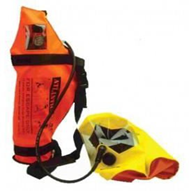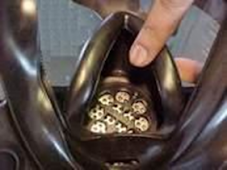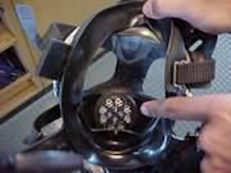BREATHING APPARATUS
Explain about EEBD and its Location and minimum
requirement onboard and how u will charge it
and how long you can be used?
What is the procedure to wear new type of EEBD?
What Maintenance will
be carried out on EEBD?
EEBD: Emergency Escape Breathing Device
To know how many life jacket
and location of jacket in your
ship please check your “fire control and safety plan”
SOLAS REQUIREMENT
- On cargo ship in accommodation min 2 & 1 spare
- One in ECR
- One near workshop
- One at each deck or platform
- EEBD must be situated ready for use and easily visible.
EEBD is to be located in easily visible areas of machinery spaces and mostly in ECR workshop and near emergency escape routes.
EEBD includes the following:
Cylinder: It consists of small cylinder carrying 2.5 liter oxygen, along with a demand valve and low pressure alarm.
Hood & face piece: Fresh air or oxygen comes inside the hood and the face piece, which are connected to the cylinder through a demand valve.
Clear window: A clear window is provided in the face piece and is made up of flame resistant material for clear sighting and smooth escaping.
Pressure indicator: To know the remaining pressure, and while you will charge to know the limit.
It shall not be used for fighting the fires, entering into oxygen deficient voids or tanks, or worn by fire fighters.
It shall have service duration of at least 10 min.
· EEBD oxygen cylinder will charged with BREATHING AIR COMPRESSOR and
suitable adopter will be used to
charge it, otherwise it may be charged by External Authority in Port.
Maintenance on EEBD
·
Check indicator needle
is in green zone, thus ensuring no leak has taken place.
(Monthly)
·
Keep the device
case clean. (Monthly)
·
Check and
record expiry dates. EEBD is valid
for 15 years.
· Do not open EEBD. Use training piece for training purpose.
SCBA
Explain about SCBA and how you will use in emergency?
How will you pressure test for remaining
air in bottle or how you will make alarm?
These include:
·
When entering into an
enclosed space
·
When entering into a space to fight fire
The Self Contained Breathing Apparatus (SCBA) or Compressed Air Breathing Apparatus (CABA):
A breathing apparatus, commonly known as a BA set or SCBA (self-contained breathing apparatus) or CABA (compressed air breathing apparatus), is a device used to supply fresh air for human breathing when Someone is entering a place where the environment is a suspect and cannot support human life.
The equipment consists of:
One or two cylinders with air under pressure
- A harness for mounting the cylinders on the person's back.
- a respiratory system consisting of a means of reducing the air pressure from the
- cylinder and supplying air to the
- wearer according to his needs, and
- A face mask attached to a demand valve, which maintains positive pressure inside the
- mask at all times.
The arrangement of a typical apparatus is as follows:
· The cylinders hold approximately 1240 liters of free air compressed, giving a full air
usage time of about 31 minutes and a working life of 21 minutes under normal conditions. Please note that usage time varies greatly from person to person and the workload being performed by the individual· A reducing valve is attached after the cylinder to reduce the pressure to about 4 bar. This pressure is further reduced by a demand valve, which is attached to the wearer's mask.· The demand valve supplies air to the wearer when he inhales and closes when he exhales· An exhalation valve releases the air removed from the facemask.· When there is about 10 minutes of air left (air cylinder pressure is about 50 bar), a warning whistle will sound continuously – warning the user that his air supply will soon run out and he will have to go outside.· This warning signal will continue to sound until the cylinder runs out of air. The facemask is made of molded rubber with a series of adjustable rubber straps to secure it over the wearer's head and fitted with a quick release arrangement· The user must have a good field of vision so that the wearer does not need to constantly turn their head. A gauge is provided to indicate the air pressure in the cylinder· Additional cylinders should be provided for each set of breathing apparatus and a small air compressor should be provided to charge these cylinders.
If the face mask is removed while the wearer is in a smoky or toxic environment, it is important that the wearer should hold their breath and immediately replace the removed Mask. If for any reason there is a possibility of delay in doing so, the wearer should. He was taken to fresh air as soon as possible, even if he felt no ill effects from it. A few breaths of contaminated air, which he has been forced to breathe.
ALARM TESTING:
Open the cylinder valve.The line will pressurize by a pressure of 200 bar.The pressure gauge indicates 200 bar pressure.Close the cylinder valve.The check pressure should not drop 10 times in a minute.Now operate the demand valve to test the alarm and the pressure will start to drop from the high pressure line.An alarm will sound when the pressure on the pressure gauge reaches about 55/60 bar.This will indicate that you now only have 8-10 minutes to escapeFunction Checks:
- Close the cylinder valve.
- Breathe normally through the vent system.
- Whistle alarm should sound during venting observe gauge at a preset pressure
- of -55bar +/- 5bar.
- When the gauge indicates zero, hold your breath. The face piece should hold onto the
- face indicating a positive seal.
- Open the cylinder valve slowly, but fully to depressurize the system.
- Breathe in and hold your breath. The unit must be balanced, ie no audible leakage.
- Keep breathing. Expired air should easily exit the exhalation valve.
- On demand rubber cover press center, supplementary supply check valve
Note: If leak detected,
open cylinder valve, readjust head harness and retest.
During Use:
·
Cylinder pressure must not be less than 80% full.
·
Check gauge reading
regularly. Whistle will sound at 55 bar +/- 5 bar.
·
When whistle sounds, exit and go to safe area,
by shortest and safest route.
·
Do Not remove equipment until in safe area, clear
of hazard.
After Use:
The cylinder pressure should not be less than 80% full.Check gauge readings regularly. Whistle at 55 bar +/- 5 bar.When the whistle blows, exit and go through the shortest and safest route to a safe area.Do not remove equipment unless it is in a safe area, free from danger.
Maintenance on face mask
Cleaning:
- The mask should be cleaned after every use.
- Do not use any organic solvents like acetone, alcohol etc.
- Wipe off the mask with a cloth and all-purpose detergent mixed with lukewarm water.
- Wash thoroughly under running water.
- The mask should be cleaned after every use.
- Do not use any organic solvents like acetone, alcohol etc.
- Wipe off the mask with a cloth and all-purpose detergent mixed with lukewarm water.
- Wash thoroughly under running water.
Disinfecting:
Drying: Leave to air dry. Maximum temperature 60 °C. Keep away from direct sunlight.
Visual inspection of speech diaphragm: The speech diaphragm and O-ring must be clean and not damaged. If not, clean or replace.
Visual inspection of inhalation valve: The inhalation valve is visible
in the mask connector. Check
by blowing into it
that both wings of the valve
disc move freely.
Replace if seized
Visual inspection of exhalation valve:
- Remove the protective cap from the connector.
- Push one arm of the spring clamp inward and remove the clamp.
- Grab the valve disc by the nipple and lift it out of the guide. The valve disc and seat must be clean and free of damage.
- Clean or replace if necessary. Wet the valve disc with water and reattach. When the seat is horizontal, the valve disc should slide into the guide under its own weight.
- Fit the spring clamp and spring so that the two clamp arms connect to the sides.
- The clamp is marked "L" = left and "'" right and fits at an angle.
Additionally requires following checks to be carried out
Every month the air bottle, bottle valve, reduction valve, intermediate hose, manometer, carry back plate, lung demand regulator, warning alarm for withdrawal and breathing mask will be checked and tested as per manufacturer's manual.
Every year all valves, ceilings and speech membranes will be inspected.The exhalation disc should be replaced every other year. This should be done even when the mask has not been used.Every five years the completed breathing apparatus will be submitted for a major service check, which should include a major overhaul of the reduction valve and pressure testing of the air bottles in an authorized workshop.Air bottles will be pressure tested by an approved service company.If an air bottle shows any signs of corrosion or if it is damaged or has become overheated, it shall be replaced immediately.











0 Comments